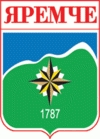Yaremche
 |
 |
Yaremche hosts the headquarters of the nearby Carpathian National Nature Park.
A possible root of the word "Yaremche" comes from the Turkish. In Turkic languages "yarım" means "half" and "yarımca" means "little half". It was founded in 1787 and received city status on December 30, 1977. In the interwar period (1918–1939) it belonged to Poland and was the most popular tourist center in eastern part of the Carpathian Mountains (in the late 1920s more than 6 000 guests came there yearly). Yaremche was growing year by year in importance and number of tourists. According to some, it had the chance to achieve same importance as other key Polish mountain spas, Zakopane and Krynica. However, in September 1939 it was captured by Soviet troops and became a part of Soviet Union as part of the Ukrainian SSR. During the World War II it was part of the Distrikt Galizien and was liberated by the Soviet forces in 1944. On December 30, 1977, the city of Yaremcha became a municipality within Ivano-Frankivsk Oblast. Since 1991 it has been a part of independent Ukraine.
There are a number of interesting houses with long sloping roofs. There is a wooden Orthodox church and an impressive rail viaduct, located over the Prut valley at the height of 30 m. Next to this there is a swinging pedestrian toll bridge.
On December 14, 2006, the Parliament of Ukraine, officially renamed the city from Yaremcha to "Yaremche". The decision was based on the results of a city referendum, as well as the recommendations of City Council, and Ivano-Frankivsk Oblast Council.
Until 18 July 2020, Yaremche was incorporated as a city of oblast significance and was the center of Yaremche Municipality which also included the urban-type settlement of Vorokhta, a ski resort, and five other villages: Mykulychyn, Polianytsia, Tatariv, Voronenko, and Yablunytsia. The municipality was abolished in July 2020 as part of the administrative reform of Ukraine, which reduced the number of raions of Ivano-Frankivsk Oblast to six. The area of Yaremche Municipality was merged into Nadvirna Raion.
Map - Yaremche
Map
Country - Ukraine
 |
 |
| Flag of Ukraine | |
During the Middle Ages, Ukraine was the site of early Slavic expansion and the area later became a key centre of East Slavic culture under the state of Kievan Rus', which emerged in the 9th century. The state eventually disintegrated into rival regional powers and was ultimately destroyed by the Mongol invasions of the 13th century. The area was then contested, divided, and ruled by a variety of external powers for the next 600 years, including the Polish–Lithuanian Commonwealth, the Austrian Empire, the Ottoman Empire, and the Tsardom of Russia. The Cossack Hetmanate emerged in central Ukraine in the 17th century, but was partitioned between Russia and Poland, and ultimately absorbed by the Russian Empire. Ukrainian nationalism developed, and following the Russian Revolution in 1917, the short-lived Ukrainian People's Republic was formed. The Bolsheviks consolidated control over much of the former empire and established the Ukrainian Soviet Socialist Republic, which became a constituent republic of the Soviet Union when it was formed in 1922. In the early 1930s, millions of Ukrainians died in the Holodomor, a man-made famine. During World War II, Ukraine was devastated by the German occupation.
Currency / Language
| ISO | Currency | Symbol | Significant figures |
|---|---|---|---|
| UAH | Ukrainian hryvnia | â‚´ | 2 |
| ISO | Language |
|---|---|
| HU | Hungarian language |
| PL | Polish language |
| RU | Russian language |
| UK | Ukrainian language |















